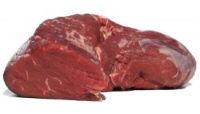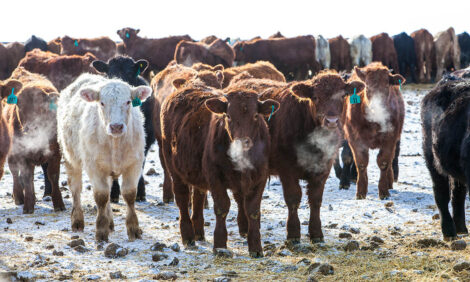



Meat Quality and Animal Welfare
It has long been known that the impact of poor animal welfare before an animal goes into slaughter can have a detrimental effect on the quality of meat. Now producers and slaughterers are beginning to understand the science behind this process and, more importantly, what it is that we can do to prevent it, writes Adam Anson, reporting for TheCattleSite.
 |
The quality of meat can be greatly altered in the last days, hours or even moments of an animals life. A small slip en route, slight dehydration, or too much exercise can all devalue the price of meat when it comes to market. Research has proven how seemingly unnoticeable levels of stress and exercise can have dramatic effects on meat quality, so how can we open our eyes to these problems?
Today, the issue of animal welfare has stepped out of the arena of just ethics; it has become an essential requirement of meat quality and one that producers and slaughterers alike must strive towards in order to improve the economic potential of their businesses.
Professor Neville Gregory, an expert in the field of animal physiology, explained to an audience at the English Beef and Lamb Executive (EBLEX) National Producer Conference how the impact of animal stress and other welfare issues can have this detrimental impact on quality and leading to the production of what he called DFD meat; Dark, Firm and Dry.
According to him, the main reason that DFD meat is not being accepted by the customer is down to appearance. The meat looks abnormal and old and, despite such judgement seems to be irrational, he goes on to explain that 'there is some truth to this deception.'
So What is the Cause of DFD Meat?
According to Prof Gregory DFD meat is caused by high levels of pH. The average level of pH in normal livestock muscle, whilst they are alive, is 7.0, but as soon as the animal has died the acidity of the meat begins to increase. Just 24 hours after slaughter the meat reaches what is known as the 'ultimate pH' of 5.5. This, he says, produces a 'natural and desirable' meat, and it is the acidity inside it that actually helps to 'keep the meat.'
The process that converts the meat to the ultimate pH is fuelled by glycogen in the blood. This is converted into lactic acid post-mortem, so the final pH content is relative to the initial content of glycogen in the blood at the time of slaughter.
Prof Gregory said that if an animal is stressed, or has exercised recently before slaughter then 'there is a chance' that it may have used up so much of the glycogen in its blood that there will not be enough left over to convert the pH to this 'optimum level'.
This problem is particularly notable in bull beef due to the often hyperactivity of the animal before slaughter.
The Effect on Blooming
 |
| A prime piece of meat Photo: Stockxchng |
Blooming is the process that turns meat into that desirable, fresh-looking red colour after the meat has been left to oxygenate.
'Oxygen from the air is taken up by the main muscle pigment; myyoglobin,' said Prof Gregory, 'but with DFD meat this does not happen. Instead the meat remains purple for a while and then begins to turn to a rotten looking brown.'
The reason why DFD meat fails to bloom properly can be explained at a molecular level. DFD meat is turgid with water and, due to how packed and condense it is on the inside, oxygen cannot penetrate deep enough to properly effect the pigment, therefore there is only a shallow colouring effect.
Despite the appearance of DFD meat being the main factor for its unacceptability, it has other failures also. Another important reason is obviously how the meat tastes. Prof Gregory explains how the DFD meat was compared to normal meat in a sample taste test.
The Taste Test
The test was based on three factors: flavour, juiciness and tenderness. Prof Gregory says that the flavour of the meat was reported to be the most obvious consequence, indicated to contain too much moisture and have an overall detrimental effect.
However, for much the same reason, the DFD meat was actually deemed to be more juicy and tender, but, despite of these slight improvements, the overall taste acceptability of the DFD meat was lower.
This research arose the question in Prof Gregory - 'why is it more tender?' And more importantly - 'can we exploit this?
Shelf-Life
Prof Gregory explained that the calpain enzyme found naturally in meat is more active in warmer temperate environments and also those with high pH levels. The enzyme is responsible for maturing meat and, as DFD meat has a high pH level, it tends to mature more readily. Therefore, it achieves its optimum quality after less hanging than normal meat, however it also begins to spoil sooner.
The poor shelf-life of DFD meat is noticeable when the product comes to market, but some of the biggest damage is done when the meat arrives at the processor, with whole consignments being turned around due to just a little spoilage of a small amount of DFD meat.
High pH meat is not a complete loss, but once it has been identified it tends to follow a different market path. No longer is it considered suitable for the meat to be put into the prime beef market, rather it will be good for pate's and frozen burgers. The high water retention of DFD meat means that it will add weight and vale to the meat, however there will be an overall loss of profit on the meat. It is estimated that DFD meat costs the UK £9 million a year and bruising sets the economy back an additional £5 million.
How to Prevent DFD Meat?
High stress levels before slaughter have a negative effect on meat quality, resulting in poorer flavour, lower acceptability, darker colour and decreased shelf-life, but what can be done to prevent it on a practical level?
To answer this question we must first get to grips with the main causes of these high stress levels in cattle. According to Prof Gregory these are:
- Over exertion
- Long distance travel
- Long periods of lairage
- Fighting
- Over-stocking in lairage
- Injury
Bruising
Bruising of muscle tissue also effects the quality of meat because the pH levels increase around the bruising. According to Prof Gregory, one of the biggest factors of bruising is through horn damage.
'Please don't send animals in with horns,' he pleaded. 'Injuries in confined places are very common in abattoirs and horn raking can scruff up the hide and render it valueless.'
Animals can also damage themselves by fighting and slipping or being abused by workers, but the most common occurrence is due to simple 'knocks around corners' as the animal is led to slaughter.
Once a damaged carcase has been identified by a member of the Meat Hygiene Service the abattoir proprietor will try to do 'a salvage job' of it, by cutting out the bruised areas and discarding of them. Any meat that is cut out will be valueless.
Washing
A surprising factor of DFD meat is due to the cleanliness of the animal when it comes into slaughter. In Britain there was a big mind set change in the 1990's to help increase food safety by controlling the level of E.coli in meat before the animal is slaughtered.
This resulted in the one in ten tolerance policy which determined that if E.coli was found to be on more than one tenth of the animals arriving at the abattoir then they would slow the whole line down until they found the root cause. However, these washing procedures upset the animals before slaughter and decrease the meat quality they produce.
Transport and Lairage
Prof Gregory described a study, recently published in West Australia, in which pH levels in cattle were measured after travelling to the slaughterhouse. It turned out that nine out of 13 consignments were found to have these high pH levels synonymous with DFD meat.
Another test examined how long it would take for the stress levels to return to normal. An overall average put the duration at three days, however that was only when the animal was rested in high welfare surroundings.
Average lairage surroundings have proved to be synonymous with increased stress levels. The longer the cattle remains in the lairage the greater the increase.
What Can the Producer do to Help Meat Quality
- Feeding hay to an animal two days before slaughter will reduce the level of E.coli in the gut and firm up the faeces. However, this requires that the animal will need to be kept off pasture and relocated for two whole days.
- A producer should maintain a good relationship with the abattoir in order to increase efficiency of the process.
- Taking the issue of disbudding seriously will reduce injury and stress of animals when they are in tightly packed areas.
- Familiarise difficult breeds with early handling and prevent the excess stress and exercise caused by an overactive animal
- Sell fattened stock in the pens at auction rather than in the auction ring.
Prof Gregory said that just a few simple measures can be taken to greatly improve the meat quality an animal produces, and in the process the welfare of the animal will increase; a win win situation for both producer and animal alike.
June 2008

